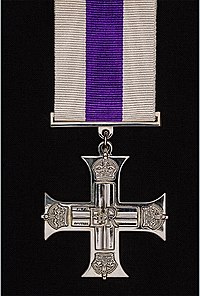
Back الصليب العسكري Arabic মিলিটারি ক্রস Bengali/Bangla Creu Militar Catalan Vojenský kříž (Velká Británie) Czech Military Cross Danish Military Cross German Cruz Militar Spanish صلیب نظامی Persian Military Cross Finnish Croix militaire (Royaume-Uni) French
| Military Cross | |
|---|---|
 Military Cross | |
| Type | Military decoration |
| Awarded for | ... gallantry during active operations against the enemy.[1] |
| Description | Obverse: Straight armed silver cross, Royal Cypher in centre Reverse: plain |
| Presented by | United Kingdom and Commonwealth |
| Eligibility | British, (and formerly) Commonwealth and allied forces |
| Status | active |
| Established | 28 December 1914 |
| First awarded | 1 January 1915 to 98 officers and warrant officers.[2] |
| Total | Including further awards:[3] George V: c. 43,500 George VI: over 11,500 Elizabeth II: c. 750 Charles III: 0 |
| Total recipients | 52,000+[4] |
without bar, and with one and two bars | |
| Order of Wear | |
| Next (higher) | Conspicuous Gallantry Cross[5] |
| Next (lower) | Distinguished Flying Cross[5] |
| Related | Military Medal |
The Military Cross (MC) is the third-level (second-level until 1993) military decoration awarded to officers and (since 1993) other ranks of the British Armed Forces, and formerly awarded to officers of other Commonwealth countries.
The MC is granted in recognition of "an act or acts of exemplary gallantry during active operations against the enemy on land" to all members of the British Armed Forces of any rank.[6] In 1979, Queen Elizabeth II approved a proposal that a number of awards, including the Military Cross, could be recommended posthumously.[7]
- ^ "Defence FactSheet: Military Honours and Awards". Archived from the original on 17 April 2010.
- ^ "No. 29024". The London Gazette (Supplement). 29 December 1914. pp. 7–9.
- ^ Cite error: The named reference
Abbott220was invoked but never defined (see the help page). - ^ Jenn Stowell (9 December 2020). "All The Gen On The Military Cross". Forces Network. Retrieved 5 March 2021.
- ^ a b "JSP 761 Honours and Awards in the Armed Forces" (PDF). p. 12A–1. Archived from the original (PDF) on 2 August 2020. Retrieved 7 November 2014.
- ^ "No. 56693". The London Gazette (Supplement). 17 October 2002. p. 11146.
- ^ Abbott & Tamplin, British Gallantry Awards, 2nd ed.. p. xx.


